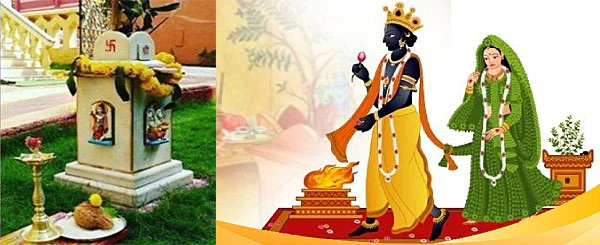Sunil Kumar D.
Tulsi Vivah is the mythical marriage of Shri Krishna, an incarnation of Lord Vishnu with the Tulsi plant (holy basil). In the Sanatana tradition, Tulsi is considered an incarnation of Goddess Lakshmi, and therefore ceremonial union of Lord Vishnu and Lakshmi is observed with great pomp and show all over the country and out of the country as well. This propitious day signifies the amalgamation of divine masculine and feminine energies. The holy plant of Tulsi is believed to be the incarnation of Devi Laxmi and this sacred plant is placed in every Hindu household.
The festival of Tulsi Vivah generally signifies the end of the monsoon, and the beginning of the wedding season in Sanatana Dharma. Every year, the ceremonial festival, Tulsi Vivah is performed on the Dwadashi date of Kartika Shukla Paksha, before the day before, on Prabodhini Ekadashi with great zeal and devotion. This year, we have Tulsi Vivah on 13 November 2024. The Dwadashi Tithi will start at 04:04 pm on 12 November 2024 and ends at 01:01 pm on 13 November 2024. This festival also marks the start of all auspicious ceremonies in the Sanatana society.
Married women observe the Tulsi Vivah puja for the well-being of their husband and family members. Young women pray to Goddess Lakshmi with full devotion to seek marital bliss. Tulsi Vivah rituals are also observed by young, unmarried women to get good husbands.
As per the popular legend, Goddess Tulsi was born as a woman, named Vrinda, who got married to an evil king named Jalandhar. She was an ardent devotee of God Vishnu and continuously prayed for her husband’s health and long life. As a result, Jalandhar became invincible. Lord Shiva requested Lord Vishnu to weaken Jalandhar’s power. Therefore, Lord Vishnu took the form of the evil king Jalandhar and deceived Vrinda. Consequent to which Jalandhar became powerless and was killed by Lord Shiva. Vrinda, on knowing the truth, cursed Lord Vishnu and drowned herself in the ocean. Lord Vishnu and other gods placed her soul in the plant which later came to be known as Tulsi. Also, Lord Vishnu married Tulsi in the next birth in the form of Shaligram (black stone) on the day of Prabodhini Ekadashi. This is the reason why Tulsi Vivah is celebrated on this day with such exuberance.
What are the rituals of Tulsi Vivah?
The marriage ceremony of the Lord Krishna with Tulsi resembles much like any traditional Sanatana wedding. The Vivah rituals are performed in various temples, however, some people prefer to perform the Tulsi Vivah at their home.
The participant of the Tulsi Vivah must observe fasting until the actual Vivah ceremonies are done.
An attractive Mandapam is set up around the Tulsi plant by using the sugarcane stalks, Banana planta, Mano leaves, and lots of fresh flowers and the platform is decorated with colorful Rangolis. Few Amla (goose berry) and tamarind tree branches are planted on the sides of Tulsi plant. In the evening, after sunset, lights are lit. The Tulsi plant is then beautifully adorned with bright red sari, earrings and other ornaments just like a Bharatiya bride. Vermillion and turmeric powders are applied to the face placed on the pot of Tulsi plant. Nose-ring and a Bindi make her look beautiful.
A brass idol of Lord Vishnu or sometimes ‘Shaligram Stone’, symbolic of Lord Vishnu is decorated as the groom with dhoti and Anga Vastram.
A special vegetarian lunch is prepared for this grandeur occasion. In the most of the household’s Puris, rice and dal, red pumpkin vegetable and a delicious sweet potato kheer is prepared. The prepared food is then kept aside for ‘Bhog’ and after the completion of marriage rituals, the food is distributes as prasadam.
The actual Wedding ceremony starts in the evening. As a part of the Vivah ceremony, both Lord Vishnu and Tulsi are given a bath and adorned with new costumes, jewelries, and flowers before the wedding. A yellow thread is used to link the couple together for the ceremony.
A priest or some women collectively can perform the Tulsi Vivah ceremony in the house. Women of all age groups can perform the ritual, but only widows are not allowed to participate in the Tulsi Vivah ceremony. The mantras are enchanted all throughout the wedding ceremony. At the completion of the marriage rites, the devotees shower rice mixed with vermillion on the newlyweds.
Normally the expenses of the Tulsi Vivah are borne by couples without daughters. They act as parents of Tulsi and perform the ‘Kanya Daan’, a ceremony of giving away their daughter, Tulsi to Lord Vishnu. In the Tulsi Vivah ceremony, at the end, all the bridal offerings are then given away to a Brahmin priest just like any Sanatana marriage ceremony, Tulsi Vivah is also commemorated with full enthusiasm and fervor. By performing this auspicious marriage ceremony, women wish to have happiness, prosperity and wealth in their life.
Tulsi Vivah celebrations are held in various temples all over Bharat with great grandeur. The celebrations are much more elaborative and there will be bride and groom’s parties. A suitable wedding invitation is sent from the bride’s party to the groom’s party. The bride’s side receives a grand Barat accompanied by dancing and singing devotees. It is a popular belief that childless couples, who perform Tulsi’s Kanya Daan, will soon be blessed with children.
Bhajans are sung all throughout the day and evening and the ceremonies end when Lord Vishnu ties Mangal Sutra to his bride Tulsi. The Tulsi Vivah is an ideal example of a Bharatiya marriage.
After the puja, a Tulsi Aarti is sung. Once the Aarti is finished, the cooked food is offered as ‘Prasadam’ with fruits. The Prasad is then eaten together with family members and other guests.
A person who observes the Tulsi Vivah should also eat a Tulsi leaf that is symbolic of Goddess Tulsi entering the devotee’s body. Prasad in the form of sweets are then distributed among all.
All kids who attend the function burn crackers. Sweets, sugar cane pieces, Churmuri (puffed rice) and coconut pieces are distributed to all the people who come to see this Pooja.







